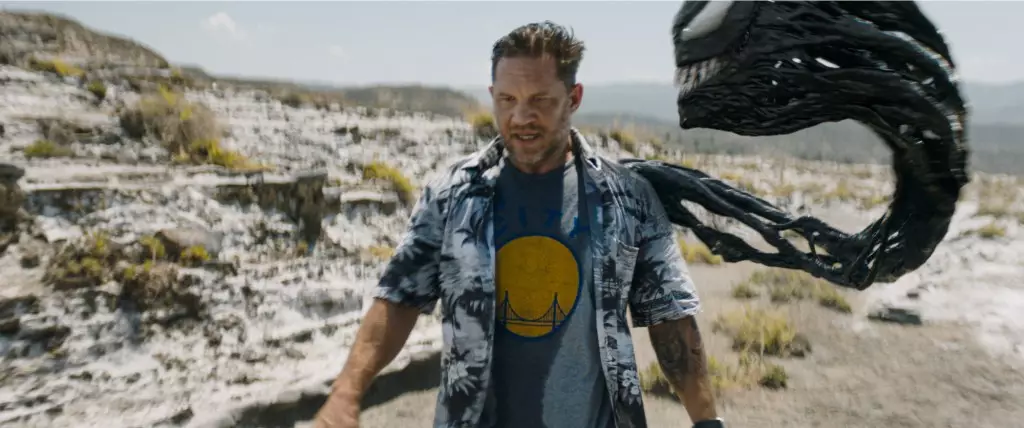The Marvel Cinematic Universe continues to expand in seemingly endless directions, but as the Venom saga unfolds with its latest film, “Venom: The Last Dance,” it raises questions about the franchise’s viability and artistic merit. This installment endeavors to blend elements of horror and comedy, yet frequently stumbles under its lofty ambitions. Delivered through a lens dominated by British talent, the performances and directorial approach merit attention but are ultimately overshadowed by a narrative burdened with predictability and constraints.
The film features an impressive lineup, with Tom Hardy reprising his role as Eddie Brock, the conflicted journalist bonded with the alien symbiote Venom. Alongside him, actors like Chiwetel Ejiofor, Juno Temple, and Rhys Ifans join the fray, enriching the film with nuanced performances. Despite their collective talent, the script fails to provide these actors with material that does justice to their abilities. The film’s tonal swings hinder character development, trapping them in archetypal roles rather than allowing them to shine. In particular, Hardy’s ability to navigate Brock’s confusing psyche remains commendable; however, the depth of his character is often sacrificed to make way for frenetic action sequences.
Directed by Kelly Marcel, “The Last Dance” marks her first venture behind the camera, and this clear in both the film’s strengths and weaknesses. Marcel’s directorial choices possess an intriguing restraint amidst the chaos that often defines superhero adaptations. She displays a knack for establishing atmosphere, particularly in the eerie setting of Knull’s prison planet. Yet, as the narrative unfolds, her leadership struggles to keep the film cohesive. The direction often episodes into a chaotic mix of humor and horror, lacking the clarity that defines more polished superhero films.
This lack of cohesion may mirror the challenges faced by supporting characters, leaving them predominantly underdeveloped. For instance, the character of Gen. Rex Strickland, played by Ejiofor, is intended to add depth to the conflict, but is instead presented as a cliché military antagonist. The film teeters perilously on the edge of parody at times, intending a fresh take but often veering into the territory of unintentional humor.
One of the film’s glaring flaws is its heavy reliance on tired Marvel tropes, mimicking the formulaic structure that audiences have come to expect. “The Last Dance” introduces Knull as a primary antagonist, who plots to bring about the end of the universe and seeks a mystical codex. However, this overarching goal feels recycled, lacking the originality that once characterized the genre. Such predictability dulls the stakes; unlike groundbreaking predecessors, “The Last Dance” struggles to forge a genuine emotional connection or sense of urgency.
The film opens against a cryptic backdrop, immediately dropping viewers into the world without providing substantial context. With the absence of thorough exposition, the storyline risks alienating newcomers. While seasoned fans may appreciate references and subtleties, a broader audience is left confused. The rushed pacing, paired with convoluted narrative threads, detracts from viewer engagement.
Visuals and Tone: A Clash of Styles
Visually, “Venom: The Last Dance” features moments of striking creativity but is bogged down by excessive digital effects. The action sequences often reach a level of frenetic energy that sacrifices clarity for spectacle. While Marcel’s efforts to create dynamic action are commendable, they frequently verge into overwhelming chaos, leaving viewers disoriented rather than entertained.
Furthermore, the tonal inconsistencies hinder emotional resonance. Moments of levity frequently divert attention from serious plot points, diminishing potential character arcs. Scenes that could illustrate Brock’s internal struggle instead deliver offbeat humor and absurdity, such as Venom’s off-the-wall dance sequence in a Las Vegas penthouse, which risks undermining the gravity of the film’s conflict.
In the end, “Venom: The Last Dance” serves as a testament to both the potential and limitations of the superhero genre in the contemporary cinema landscape. The film’s commitment to a blend of comedy, horror, and action is laudable, but it ultimately succumbs to a reliance on worn tropes and uneven execution. The vibrant cast and first-time director offer glimmers of hope for future installments, but the franchise requires a significant recalibration to enhance its storytelling capabilities.
In a market hungry for innovation, audiences may find themselves longing for fresher narratives and more compelling adventures. As “The Last Dance” brings the Venom saga to a temporary close, it’s clear that the franchise must evolve—steering away from predictability and embracing creativity—to resonate deeply with audiences and secure its place within the ever-evolving tapestry of superhero cinema.

